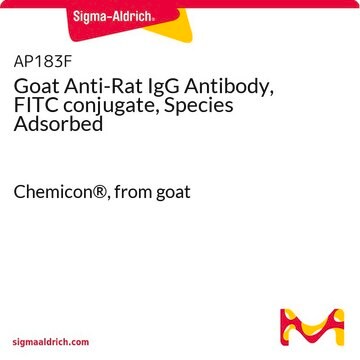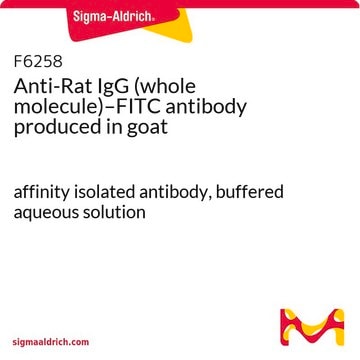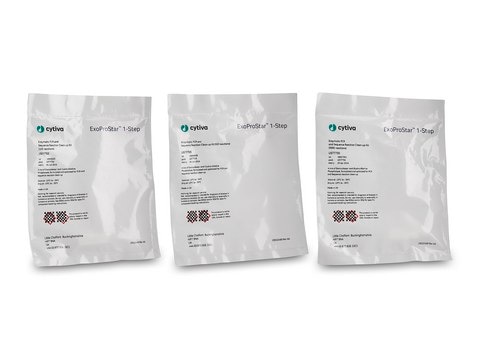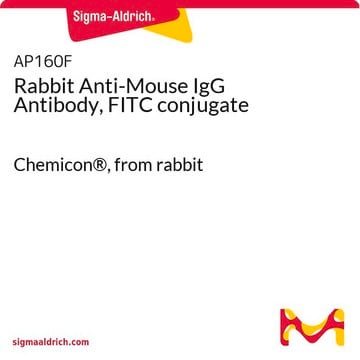AP136F
Goat Anti-Rat IgG Antibody, FITC conjugate
26 mg/mL, Chemicon®
Sign Into View Organizational & Contract Pricing
All Photos(1)
About This Item
UNSPSC Code:
12352203
eCl@ss:
32160702
NACRES:
NA.46
Recommended Products
biological source
goat
Quality Level
conjugate
FITC conjugate
antibody form
F(ab′)2 fragment of affinity isolated antibody
antibody product type
secondary antibodies
clone
polyclonal
species reactivity
rat
manufacturer/tradename
Chemicon®
concentration
26 mg/mL
technique(s)
immunofluorescence: suitable
shipped in
wet ice
target post-translational modification
unmodified
Specificity
Reacts with Rat IgG gamma chain, as well as the light chains from all rat immunoglobulin classes. Monospecific on IEP against whole rat serum. Single band on IEP at a concentration of 10 mg/mL when run against rabbit anti goat whole serum.
FLUOROPHORE/ PROTEIN:
Approximately 12 mg/mg.
FLUOROPHORE/ PROTEIN:
Approximately 12 mg/mg.
Immunogen
Highly purified Rat IgG isolated from pooled normal rat serum.
Application
Goat anti-Rat IgG Antibody, FITC conjugate is an antibody against Rat IgG for use in IF.
Research Category
Secondary & Control Antibodies
Secondary & Control Antibodies
Research Sub Category
Whole Immunoglobulin Secondary Antibodies
Whole Immunoglobulin Secondary Antibodies
Storage and Stability
When protected from light, the lyophilized antibody conjugate is stable at 2-8°C.
DO NOT FREEZE.
DO NOT FREEZE.
Legal Information
CHEMICON is a registered trademark of Merck KGaA, Darmstadt, Germany
Disclaimer
Unless otherwise stated in our catalog or other company documentation accompanying the product(s), our products are intended for research use only and are not to be used for any other purpose, which includes but is not limited to, unauthorized commercial uses, in vitro diagnostic uses, ex vivo or in vivo therapeutic uses or any type of consumption or application to humans or animals.
Not finding the right product?
Try our Product Selector Tool.
Hazard Statements
Precautionary Statements
Hazard Classifications
Aquatic Chronic 3
Storage Class Code
11 - Combustible Solids
WGK
WGK 3
Certificates of Analysis (COA)
Search for Certificates of Analysis (COA) by entering the products Lot/Batch Number. Lot and Batch Numbers can be found on a product’s label following the words ‘Lot’ or ‘Batch’.
Already Own This Product?
Find documentation for the products that you have recently purchased in the Document Library.
Gioia Marino et al.
Science advances, 9(28), eadh1403-eadh1403 (2023-07-14)
Intensive physical activity improves motor functions in patients with Parkinson's disease (PD) at early stages. However, the mechanisms underlying the beneficial effects of exercise on PD-associated neuronal alterations have not been fully clarified yet. Here, we tested the hypothesis that
Zheng Liu et al.
Redox biology, 52, 102305-102305 (2022-04-04)
Hepatocellular cell death and macrophage proinflammatory activation contribute to the pathology of various liver diseases, during which XBP1 plays an important role. However, the function and mechanism of XBP1 in thioacetamide (TAA)-induced acute liver injury (ALI) remains unknown. Here, we
Shintaro Nakao et al.
The American journal of pathology, 171(3), 1058-1065 (2007-08-11)
Dexamethasone, a synthetic corticosteroid, is widely used as a potent anti-inflammatory drug in various diseases including corneal angiogenesis. However, dexamethasone's impact on interleukin (IL)-1beta-dependent inflammatory angiogenesis is unknown. Here, we show that dexamethasone inhibits IL-1beta-induced neovascularization and the expression of
Alessandro Tozzi et al.
Brain : a journal of neurology, 144(11), 3477-3491 (2021-07-24)
Misfolding and aggregation of α-synuclein are specific features of Parkinson's disease and other neurodegenerative diseases defined as synucleinopathies. Parkinson's disease progression has been correlated with the formation and extracellular release of α-synuclein aggregates, as well as with their spread from
J K L Woodward et al.
Eye (London, England), 19(3), 342-348 (2004-07-20)
To establish if invasive and noninvasive uveal melanomas have differences in expression of adhesion molecules, and whether their adhesive interactions with the extracellular matrix (ECM) and endothelium vary. Cells from an invasive and noninvasive uveal melanoma cell line and hepatic
Our team of scientists has experience in all areas of research including Life Science, Material Science, Chemical Synthesis, Chromatography, Analytical and many others.
Contact Technical Service








